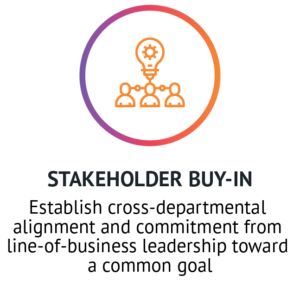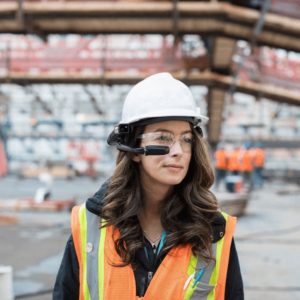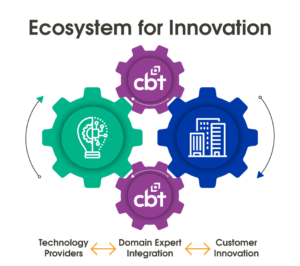Key Principles of Technology-Driven Operations
When developing an end-to-end industrial internet of things (IIoT) solution, it’s important to have both a vision and a plan. Setting objectives and benchmarks will help guide you and your company through the journey.
Compartmentalizing the process helps set realistic expectations and boundaries so your goals are achievable. To reach the goal of technology-driven operations, your company should keep in mind 3 key principles: automate, secure, and protect. Following these principles requires support from line-of-business leadership and an ecosystem of technology partners.
Finding an IIoT Sponsor
 To successfully develop an IIoT plan, you will need a sponsor within the company. Executive top-down backing will help your initiatives gain momentum and funding.
To successfully develop an IIoT plan, you will need a sponsor within the company. Executive top-down backing will help your initiatives gain momentum and funding.
To win over a sponsor, you need to inspire confidence in your ability to realize your vision. You must communicate with others, including leaders at your organization, about the technology and continue to update the team through progress reports and training programs.
Once you have developed a plan, you must stay on course to reach completion. The plan should include connectivity, data management, analytics solutions, as well as the end-user. People are the biggest reason for the success or failure of these solutions.
During the process, keep people connected and bring them in on the vision. A company that succeeds with IIoT embraces communicating with the team, makes efforts to educate and train, and puts worker safety at the leading edge, using the technology to improve the human condition.
Not sure where to start? Learn about Quickstart, a design-thinking ideation session used to make quick progress around complex needs.
Automate, Secure, and Protect
IIoT is all about data management. Data management supports the automation of processes for greater efficiency and also ensures workers have access to the information they need to perform their jobs in the field.
 Connected Worker technology is a great place to start to automate, secure, and protect. Connected Worker becomes the method by which you access all the data needed to deliver answers to the workers to make them safer. With Connected Worker, a head-mounted wearable device enables two-way audio and video communication between workers, as well as access to data and crucial documents. The solution can be customized and built out to be more impactful, including the use of tablets, smartphones, and other smart connected devices.
Connected Worker technology is a great place to start to automate, secure, and protect. Connected Worker becomes the method by which you access all the data needed to deliver answers to the workers to make them safer. With Connected Worker, a head-mounted wearable device enables two-way audio and video communication between workers, as well as access to data and crucial documents. The solution can be customized and built out to be more impactful, including the use of tablets, smartphones, and other smart connected devices.
Ultimately, Connected Worker becomes the hub for the rest of the IIoT wheel, delivering a quick return on investment and showing small wins that will encourage support from leadership for the larger IIoT project. The technology can also satisfy a multitude of use cases. Connected Worker can be integrated with existing IT solutions, such as SAP and Oracle, to create holistic solutions.
Making the Connection
Another key to a successful IIoT plan is connectivity. Many companies that begin IIoT projects lose interest because they don’t see results. What these companies need is integration engineering expertise to gain the connectivity required to bring technologies and people together.
Integration engineering covers multiple disciplines and makes it possible to improve both human performance and change management. Not every company wants to get into connectivity and become an integrator. It requires a central skill set belonging to domain specialists in areas that other companies are lacking.
 These projects also require an ecosystem of complementary partners, because one single company can’t supply every technology you need for end-to-end IIoT. Technology is changing so quickly that, to take advantage of the evolution, you must look across an ecosystem of technology partners with the help of an adept integration company to bring the pieces together.
These projects also require an ecosystem of complementary partners, because one single company can’t supply every technology you need for end-to-end IIoT. Technology is changing so quickly that, to take advantage of the evolution, you must look across an ecosystem of technology partners with the help of an adept integration company to bring the pieces together.
An integrator can guide you through this ecosystem approach by identifying which companies offer technologies to address your particular use cases, how each individual technology complements the others, and how to best leverage resources from each partner.
IIoT is about boosting profits and optimizing business processes, but it also has the goal of improving worker safety and the human condition. When technologies are successfully integrated and the solution is properly expressed, designed, and implemented, it will take workers out of harm’s way and improve their lives.
Getting the Keys to IIoT
To succeed with end-to-end IIoT, you need to invest in complementary technologies that build toward achieving your overarching vision. This strategy can save your company money in the long run, but you need to consider how all these technologies speak to each other.
This is where CBT comes in. We provide best-in-class IIoT solutions through our IIoT Practice and Connected Worker solutions. Integration and connectivity are our bread and butter. If you need your technologies to communicate, we are the best.
